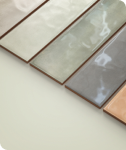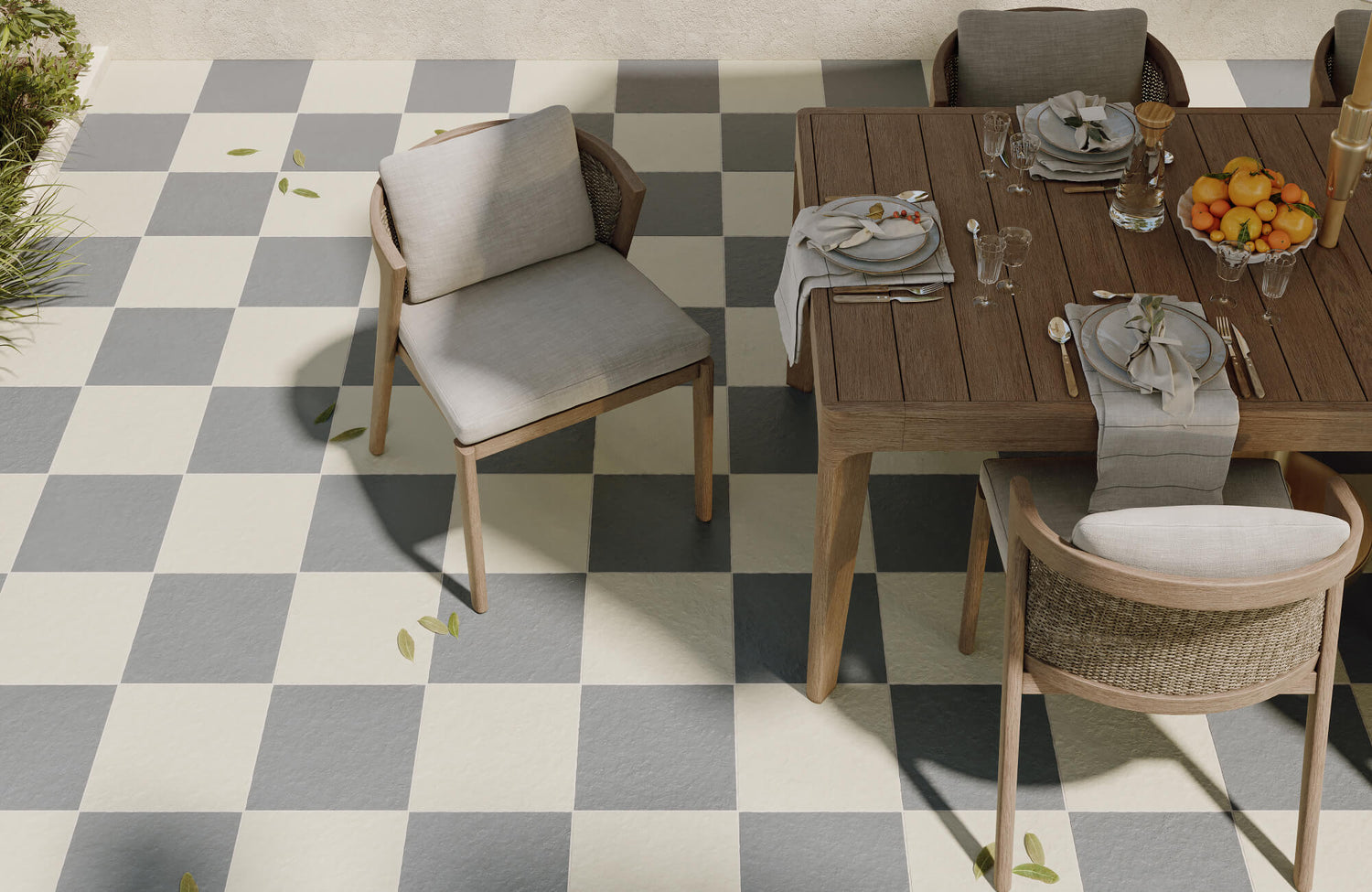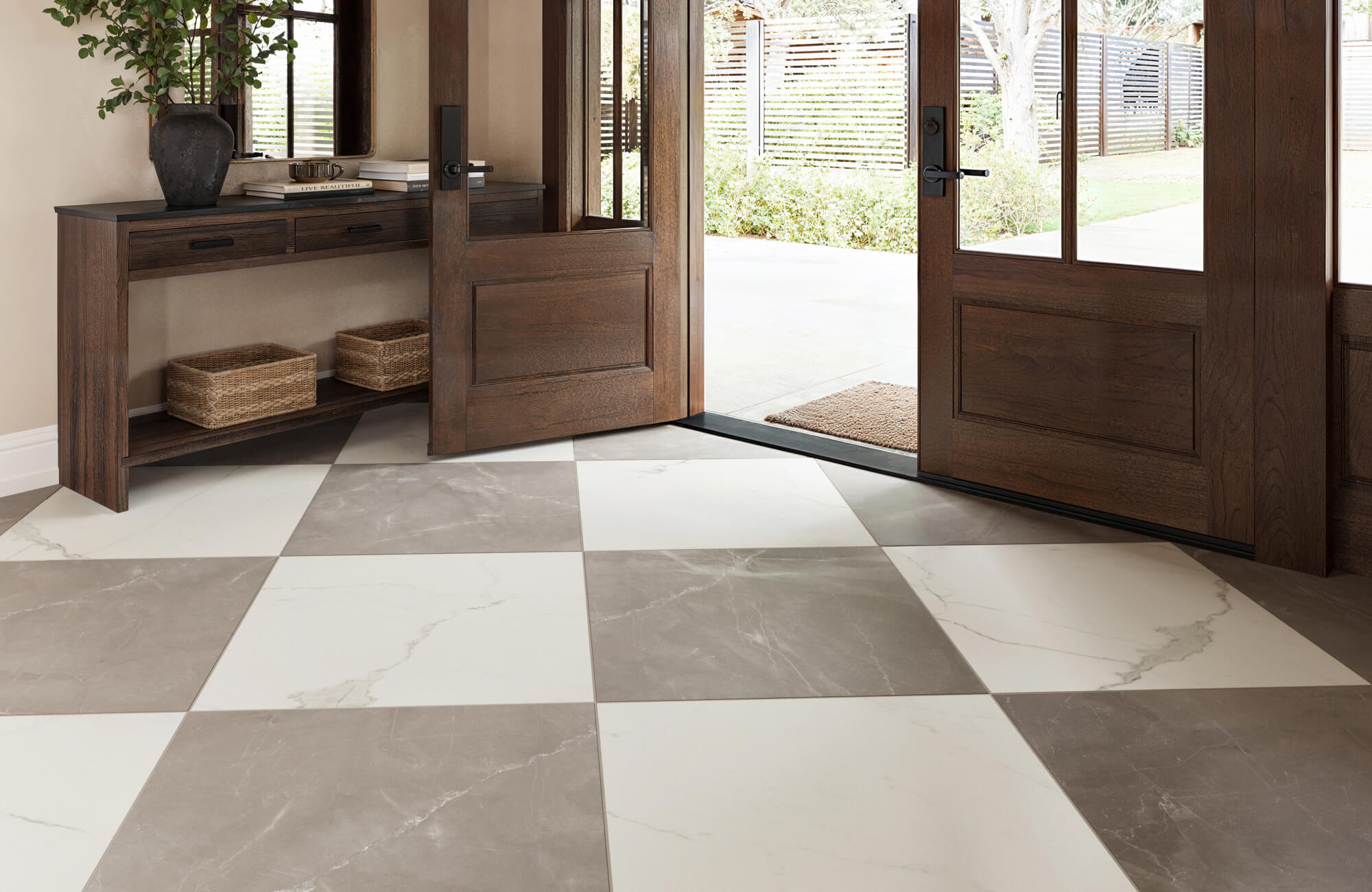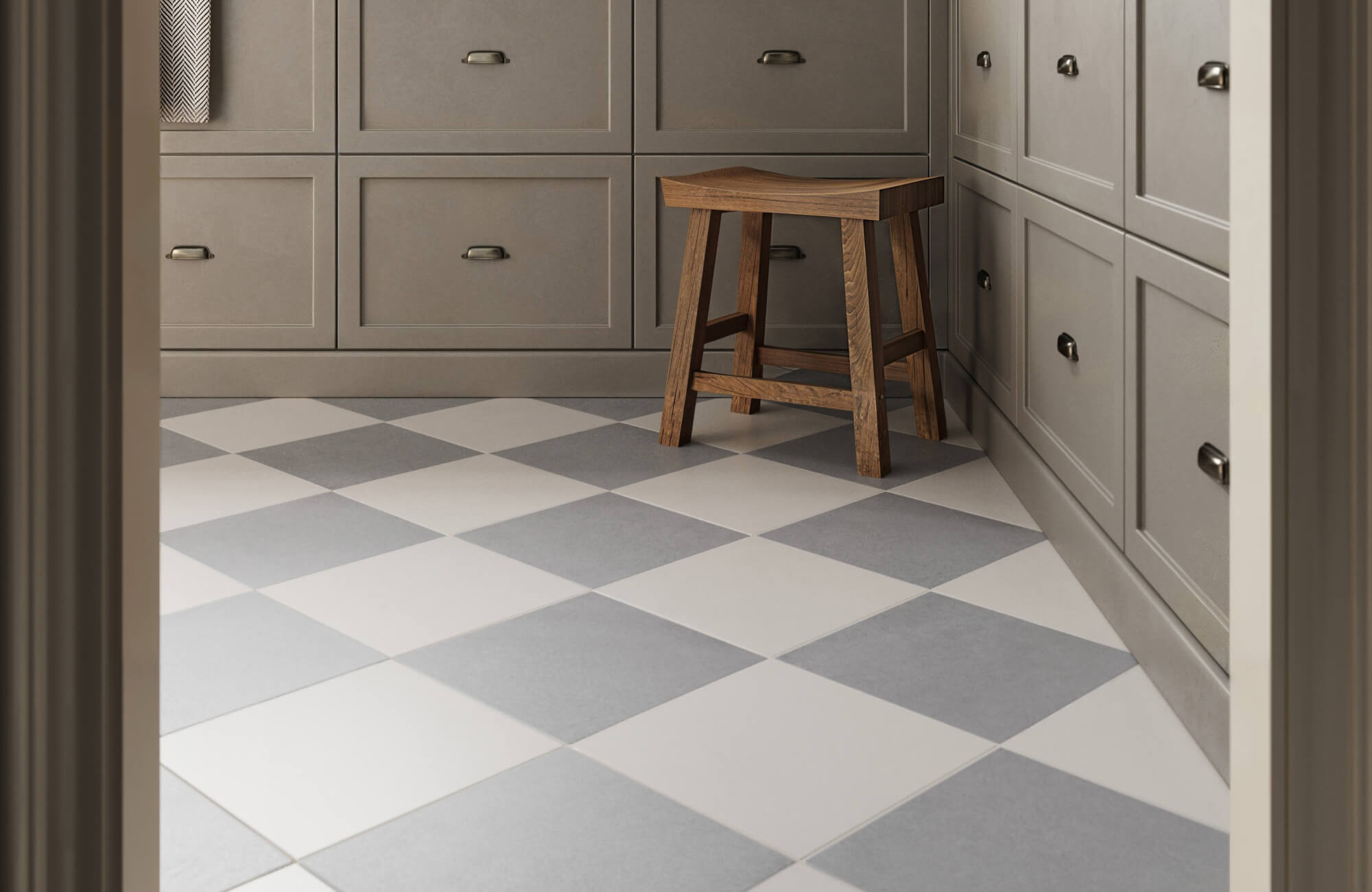Checkered tiles have a way of turning everyday spaces into bold design statements. Whether you're dreaming of a classic kitchen floor or looking to modernize a grand entryway, finding the right size is key. We’re here to walk you through what those sizes mean, how to choose based on your space and style, and what to expect during planning and installation. With our help, you’ll move confidently toward a checkered design that fits beautifully with how you live and what you love.

Common Sizes of Checkered Tiles
Choosing the right checkerboard tile size isn't just about what looks good, it's also about how the size interacts with your space, lighting, and design goals. Each range of tile sizes serves a unique purpose, and we’ll help you understand which one is the right fit for your project.
Small Checkered Tiles
Small checkered tiles, typically ranging from 4 by 4 to 8 by 8 inches, bring a sense of craftsmanship and precision that larger tiles simply can’t replicate. They’re ideal when you want to introduce visual texture without overpowering the space. Thanks to their compact format, these tiles allow for tighter, more detailed patterns, adding subtle dimension to intimate areas like powder rooms or breakfast nooks.
As displayed in the photo above, Edward Martin’s Ellie 5x5 Matte Ceramic Tile in Tan offers a warm, refined approach to the checkered look. Its soft matte finish and balanced neutral tones create a soothing backdrop that complements natural wood tones and brushed brass fixtures. These tiles are also effective in bathrooms where a calm, spa-like atmosphere is desired.
Moreover, in narrow hallways or older homes with distinctive architectural features, small checkered tiles do more than fill the floor; they also enhance the character of the space. Their scale works in harmony with charming quirks like original trim, built-ins, or curved thresholds, rather than competing with them.
That level of detail does come with a few considerations. Since smaller tiles cover less surface area individually, you’ll need more of them, meaning more grout lines and a slightly longer installation process. It’s something to keep in mind as you plan your timeline and budget. Still, the result is well worth the effort. You’ll end up with a tailored, high-end finish that’s hard to replicate with larger checkerboard tiles. If you’re envisioning a vintage-style mudroom or a European-inspired bathroom, smaller checkerboard tiles like Ellie offer both the flexibility and design precision to bring that vision to life.
Medium Checkered Tiles
Medium-sized checkered tiles, such as Leona 12x12 Checkerboard Matte Porcelain Tile in Marfil and Nero Marquina, strike a well-rounded balance between bold visual appeal and everyday functionality. It's no surprise they’re a go-to choice for many projects as they create a defined, structured pattern that stands out without overwhelming the room. Whether you're refreshing a kitchen, adding character to a hallway, or laying a patio floor, this size keeps the design clean and composed. It avoids the meticulous layout demands of smaller tiles while sidestepping the scale challenges of larger ones.
What makes this tile size especially adaptable is its ability to blend effortlessly into transitional spaces, those areas where one room flows into another. In these settings, the checkered pattern remains clear and defined without overwhelming the overall design. It’s bold enough to ground the space, yet understated enough to let other elements stand out. At the same time, medium tiles pair well with a wide range of furnishings and aesthetics, from clean-lined modern decor to more rustic, traditional interiors.
Aside from aesthetics, this size also offers practical advantages. With fewer grout lines than small tiles and a more manageable format than large ones, installation tends to be quicker and more cost-efficient. If you’re looking for a versatile option that works across different rooms and design goals, medium checkered tiles are an easy, elegant solution.
Large Checkered Tiles
Large checkered tiles, like Leona 24x24 Checkerboard Matte Porcelain Tile in Calacatta and Amani Bronze, can make a bold, clean-lined statement. These tiles are especially well-suited for open areas such as living rooms, grand entryways, and outdoor terraces. With fewer grout lines and a wide surface area, they simplify the visual landscape of the floor almost instantly. The effect is smooth, modern, and architectural, giving the entire space a sense of cohesion and contemporary polish.
What truly sets large tiles apart isn’t just their size, but how they emphasize structure and geometry. You’re not simply covering a surface, you’re also designing a grid that interacts thoughtfully with your furniture layout and sightlines. This creates a rhythm throughout the room that feels intentional and visually engaging.
However, their generous proportions do come with a few practical considerations. Due to their weight and scale, large tiles often require a reinforced subfloor and careful leveling to ensure long-term durability. That’s where professional support becomes essential. We’ll guide you through every step, from assessing the foundation to choosing the right tools and adhesives, so your checkered floor stays flawless for years.

Factors to Consider When Choosing Checkered Tile Size
Now that you're familiar with the standard size options, it’s important to consider what truly guides the right choice for your space. Every room has its personality, and the tile size you choose also plays a big role in whether that character shines through or gets overshadowed.
Space Size
The physical dimensions of your space should be the first thing you assess. If you're working with a narrow entryway or a compact laundry room, smaller tiles, typically between 4 by 4 and 12 by 12 inches, make more sense. They can help maintain visual balance, keeping the pattern proportional and preventing the area from feeling cramped or overly busy. In contrast, using oversized tiles in tight quarters can feel like forcing a puzzle piece where it just doesn’t belong.
Larger spaces, by contrast, offer room for checkered patterns to fully express themselves. Tiles like the Brody 24x24 Checkerboard Matte Porcelain in Sand and Smoke, as shown in the photo above, can bring structure and elegance to expansive rooms. In open-plan living areas or naturally lit great rooms, these large format tiles also allow the checkered pattern to stretch out and breathe. As a result, the layout feels intentional and not imposed. Instead of overwhelming the room, the pattern becomes a grounding element, guiding the eye and tying the space together.
Desired Look
Alongside space size, your design vision also plays a key role in determining the right checkerboard tile. Think about the overall mood you want to create. Perhaps you’re drawn to timeless elegance, like the classic black and white floors of a Parisian café. Or maybe you prefer a softer, more understated checkerboard that blends seamlessly into a Scandinavian-inspired space. In these cases, small to medium checkered tiles, typically ranging from 4 by 4 to 12 by 12 inches, are often the right choice. Their scale allows for more intricate detailing, making them ideal for traditional interiors with features like curved moldings, vintage hardware, or layered textures.
By contrast, larger tiles such as 24 by 24 inches can evoke a more modern and architectural feel. With fewer grout lines and bold, uninterrupted shapes, they also work beautifully in spaces that favor simplicity and clarity; think sleek finishes, crisp silhouettes, and open floor plans. If your aesthetic leans mid-century, industrial, or minimalist, these large format checkered tiles can also reinforce that clean, structured atmosphere with ease.
Grout Lines and Cleaning
Grout lines might seem like a small detail, but they can have a big impact on both appearance and upkeep, especially over time. When using smaller checkerboard tiles, you're naturally introducing more grout joints into the design. While this can add visual rhythm and definition to your checkered pattern, it also means more surface area to clean and maintain. In frequently used spaces like kitchens or mudrooms, that added upkeep can become noticeable. Grout lines tend to attract dirt, absorb stains, and show discoloration more quickly, which may require more frequent attention to keep them looking fresh.
On the other hand, larger tiles like Blair Checkerboards offer a more streamlined solution. With fewer joints between tiles, there’s less space for grime to settle, making routine cleaning much quicker and easier. For households with pets, children, or simply a busy day-to-day pace, this can make a significant difference. You can still achieve the bold, graphic impact of a checkered floor, just with less effort spent on maintenance. In the long run, fewer grout lines can also mean more time enjoying your space and less time scrubbing it.
Durability and Use Patterns
How much activity your space sees daily can significantly affect which tile size will perform best over time. In busy areas like entryways, hallways, or mudrooms, durability isn’t just a nice-to-have; it becomes essential. Small to medium-sized checkerboard tiles, ranging from 4 by 4 to 12 by 12 inches, include more grout joints, which can be more susceptible to wear. With constant movement, along with dirt or moisture, grout may chip, crack, or even loosen tiles over time, particularly if the subfloor isn’t perfectly level or properly prepared.
On the other hand, larger checkerboard tiles, especially those in the 24-by-24-inch range, tend to provide a more stable and resilient surface. Thanks to their thicker format and fewer grout lines, they’re often better equipped to handle the pressures of everyday use, making them a practical and stylish choice for high-traffic areas where performance really matters.

Additional Considerations
Size is a huge part of the equation, but it's not the whole story. Material, room layout, and visual flow play a crucial role, too. Let’s explore the supporting elements that help your tile choice succeed.
Material Matters
While tile size plays a key role in design, the material you choose can also have an even greater impact. It influences not just the look of the space, but also how the tile performs in terms of weight, moisture resistance, and overall layout compatibility. Porcelain and ceramic tiles remain popular for good reason; they’re durable, water-resistant, and available in a wide range of sizes, making them a versatile choice for kitchens, bathrooms, and most interior spaces.
On the other hand, natural stone tiles like marble or travertine offer a unique aesthetic and tactile appeal. However, they also bring added considerations. Because of their porosity and weight, these materials often require sealing and more precise installation methods, particularly when used in larger formats.
This is where balancing material with tile size becomes especially important. For example, if you're leaning toward large format stone tiles, you’ll need to make sure your subfloor can support the additional weight and that installation accounts for proper sealing. In contrast, smaller porcelain tiles are generally easier to cut and install. And while they do result in more grout lines, the tiles themselves require no sealing, which makes them an excellent low-maintenance option for everyday use.
Ultimately, material choice isn’t just a matter of style; it also affects how your floor feels, how it wears, and how much upkeep it will need as part of your daily routine.
Design Harmony
Even the most beautiful checkered pattern can fall flat if it feels disconnected from the rest of the room. To create a cohesive look, it’s important to consider how tile size interacts with surrounding elements like furniture scale, lighting, wall colors, and even the materials used in adjacent spaces. Oversized tiles, such as 24 by 24 inches, can overpower smaller furnishings, making them appear undersized or misplaced. Conversely, smaller tiles like 4 by 4 to 8 by 8 inches can feel too delicate when paired with bulky cabinetry or large-scale fixtures. Keeping the proportions balanced helps your design feel intentional rather than competing for attention.
How your checkered tile area transitions into other flooring types is also important. Whether it's meeting hardwood, concrete, or a different tile pattern, the shift should feel seamless. Tile size plays a subtle but crucial role here. For instance, medium-sized tiles, typically 12 by 12 to 18 by 18 inches, often provide a smooth visual bridge between contrasting design styles. A checkered kitchen floor in this size range can also link a contemporary space to a more traditional dining room without creating a jarring break.
How to Visualize and Test Your Tile Choice
We know that choosing tile size can be hard to picture, especially when you're looking at swatches or online photos. That’s why we always recommend testing your design before committing.
Start with painter’s tape or cardboard cutouts on the floor. Use actual tile dimensions to mark the space and see how the pattern lands. It’s a quick and low-cost way to spot potential issues with alignment, spacing, or proportions.
For a more immersive experience, Edward Martin offers a no-app Augmented Reality viewer that lets you project different tile sizes directly into your space using your phone’s camera. It’s a fast, intuitive way to see how everything will come together—and can make all the difference when it comes to choosing with confidence.
Another smart move is to bring home one or two actual tile samples. Lay them in different lighting conditions throughout the day. The color tone, size perception, and pattern visibility can shift with light and shadows. This kind of upfront testing can also help you feel confident, prepared, and satisfied before a single tile is set.

Design Ideas for Checkered Tiles
Here’s where the fun begins. Once you've chosen the right size, it’s time to explore how that choice plays into different styles. Checkered tiles aren’t limited to black and white, and they’re far from one-size-fits-all. Let's look at some fresh layout approaches.
Classic Checkerboard with a Twist
You can’t go wrong with black and white, but a few thoughtful design choices can take the classic checkerboard to a whole new level. One way to add interest is by playing with texture; mixing matte and polished finishes within the same color palette can create beautiful depth and subtle contrast. If you're aiming for a softer, more refined look, consider swapping out stark black for charcoal or using cream in place of bright white.
A great example of this refined approach is the Leona 12x12 Checkerboard Polished Porcelain Tile in Calacatta and Amani Bronze, as shown in the photo above. Its polished finish lends a luxurious sheen, while the combination of warm, stone-inspired tones transforms the classic checkerboard into something softer and more spa-like. It’s an ideal choice for bathrooms, entryways, or any space where you want to blend timeless elegance with a modern sensibility.
Diagonal Checkerboard
Changing the orientation of your tiles can dramatically change the feel of a space. A diagonal checkerboard layout introduces movement and visual interest, guiding the eye across the room and adding a sense of energy. It’s a simple shift, but one that can make a big impact, especially in long hallways or square rooms that need a bit of visual momentum.
This approach pairs best with square tiles and works well at any size. Whether you're working with a compact area or a larger floor plan, this layout technique has a way of opening up the space, making it feel more dynamic and expansive without overwhelming the design.
Bordered Checkerboard
Adding a border tile around your checkered layout brings a sense of structure and refinement to the design. It not only defines the area but also gives the pattern a more finished, designer-quality look. For a bold, eye-catching effect, consider using a contrasting color. Conversely, if you're aiming for a more subtle look, staying within the same color palette can create a smooth, cohesive transition.
In addition, borders are especially useful in open-concept spaces, where they can help visually separate different zones, like distinguishing a kitchen from an adjacent dining area without the need for walls or dividers. It’s a simple yet impactful detail that brings clarity, balance, and a sense of intentional design to the entire layout.
Choosing the Right Checkered Tile Size
Finding the right checkered tile size is about more than fitting squares into a space, it’s also about creating the kind of atmosphere you want to live in. The size of the tile also helps shape how a room feels, whether you’re after something detailed and intimate, balanced and adaptable, or bold and open. But size works best when considered alongside other design choices like material, layout, and how the space is used every day.
With a clear vision, a little planning, and the right support, choosing a tile size becomes less about guesswork and more about expression. At Edward Martin, we’re here to help you pull it all together, so you can move forward with a design that looks great, fits your lifestyle, and feels like home.







